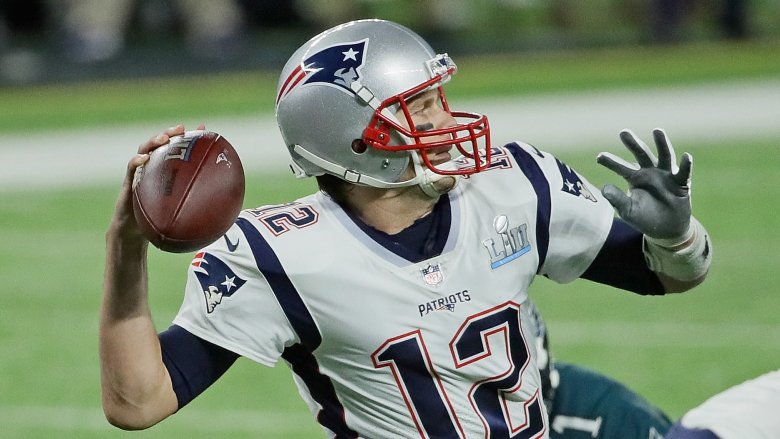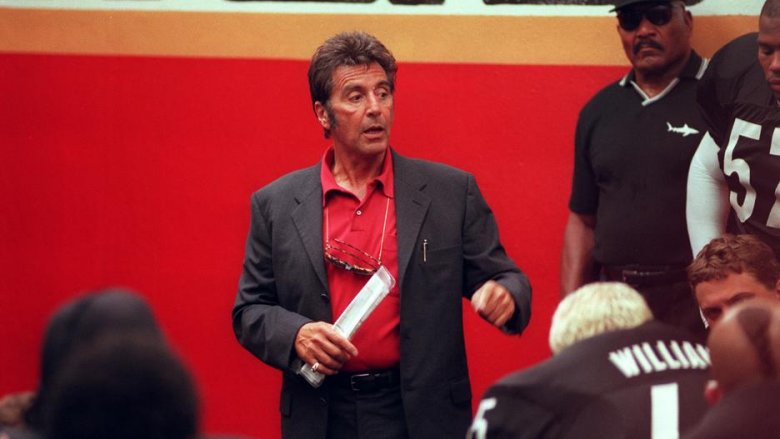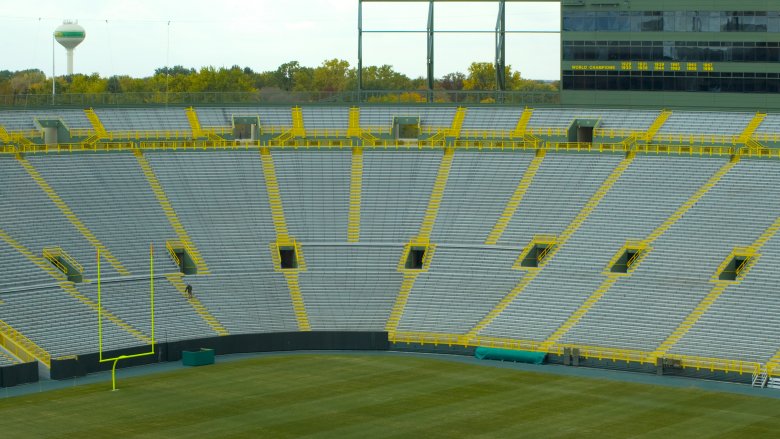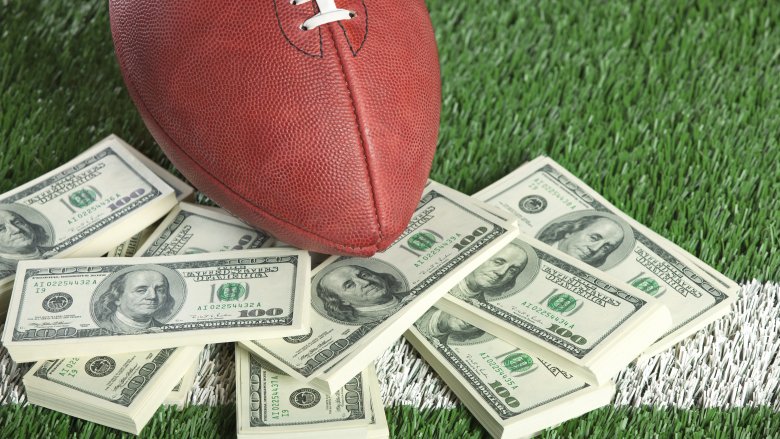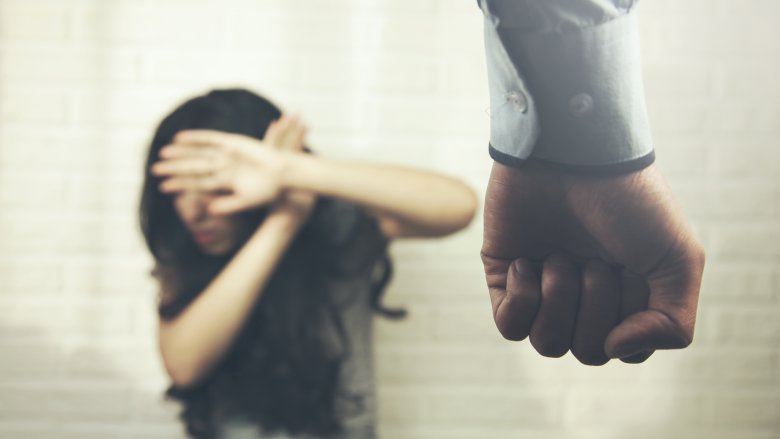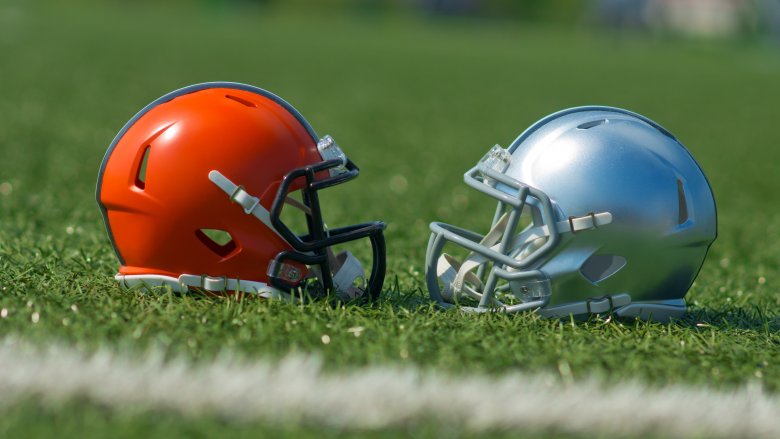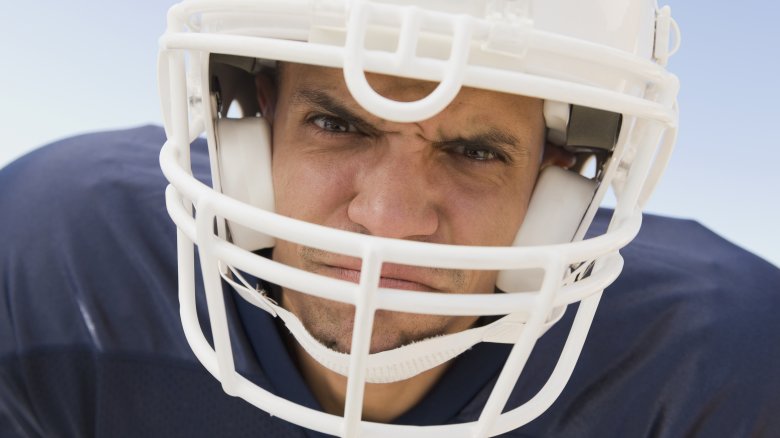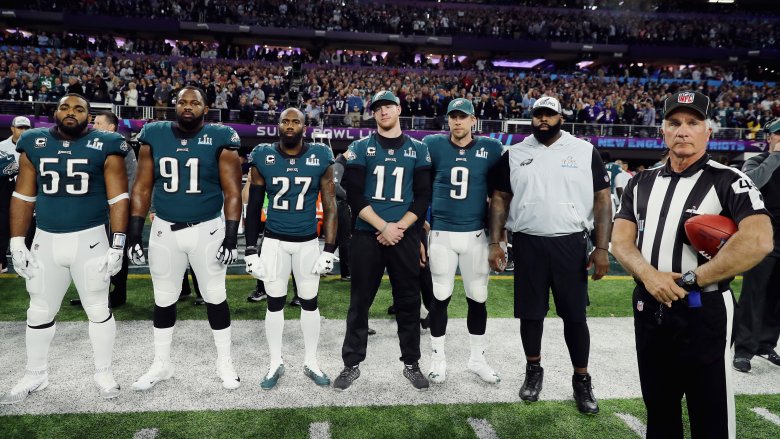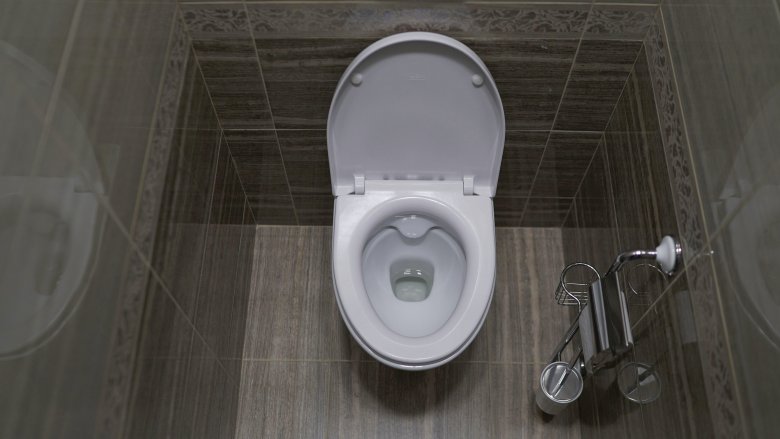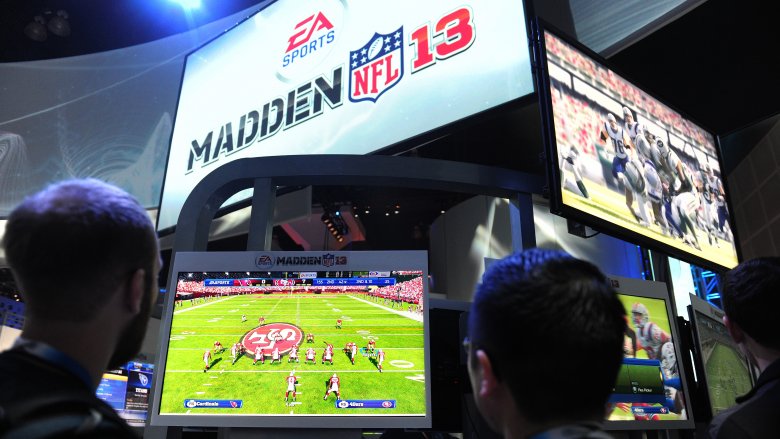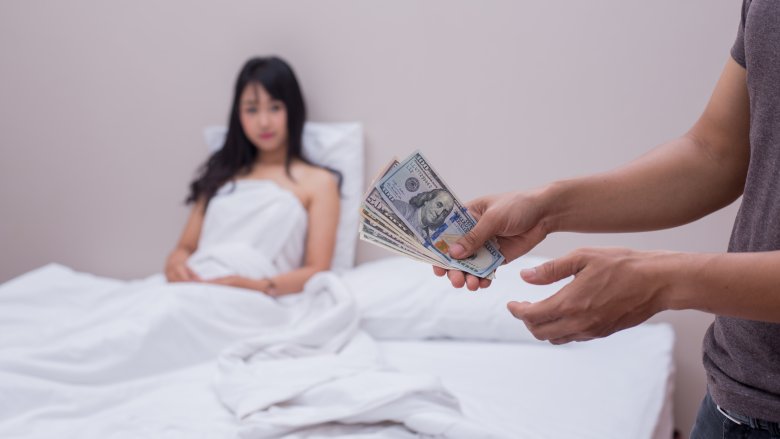False Facts About The NFL You Always Thought Were True
While it has sometimes seen controversies and a drop in viewership, Americans still love the NFL. The rest of the world might not understand why the Yanks have a game played almost exclusively with hands and call it "football," but it doesn't matter. According to a 2018 Gallup poll, 37 percent of surveyed adults picked football as their favorite sport to watch, with basketball coming a distant second at 11 percent. No matter how many deflated balls or dog fighting rings or concussions are involved, viewers seem to really enjoy watching huge guys slam into each other over and over again.
And since so many people are obsessed with it, some very bizarre rumors have cropped up around the NFL. Plenty of armchair quarterbacks consider themselves experts on everything football and repeat some of the craziest things. Fortunately, you can break the cycle because there's plenty of information out there to help bust these myths.
Halftime is full of rousing speeches
Movies about football are nothing if not predictable. The ragtag underdog team is down at halftime. It looks like their dreams of winning the championship are over. You can see it on their faces; they are demoralized, have lost hope. But there is one last chance for them. The coach stands in the middle of the locker room and gives a speech, starting slow and driving forward to a crescendo of emotion and brotherhood. By the end the players jump up, ready to kick butt. Men and women alike in the audience burst into tears. The team comes back against all odds and lifts the trophy, thanks to their leader's Churchillian powers of motivation.
If every screenwriter includes this scene, surely it must be based on reality, right?
Nope. According to people who have been there and talked to the LA Times, halftime at football games is nothing like Hollywood's version. First of all, the break is only 13 minutes long, and players have to fit a lot of stuff in. Most of them really have to go to the bathroom when they get off the field. They choke down a protein bar. During the Super Bowl, which has a 30-minute halftime, they end up watching Beyoncé or whoever on a locker room TV. The coach might get five minutes of their time where they will come up with deep pronouncements like "here are the plays to look out for in the second half." Hardly worth putting on the big screen.
Teams are good for the local economy
NFL teams sometimes ask taxpayers for obscene amounts of cash to build state-of-the-art new stadiums. To get what they want, they try to prove that having a professional football team in the area is great news for everyone, and that the local economy would be destroyed if they, say, packed up and moved to that harlot Los Angeles.
Conveniently, the NFL Players Association commissioned a study, cited in the Washington Post, that found having a team adds 110,000 jobs to a city and $5 billion to the economy. Very impressive numbers! If only they were accurate.
Other studies have found nothing of the sort. One economist called the NFL's numbers straight-up propaganda. He and 16 collaborators compared the economies of cities with new stadiums to the economies of cities that had invested similar amounts of money in other things. They found having a sports facility had a teeny-tiny positive effect at best, and sometimes even a negative one on economic activity and employment. Another study by a financial-services company found the same thing. The reason behind it is simple: People have a certain amount of money they spend on entertainment. If there's an NFL team, they'll spend more money on football-related stuff, but less on other fun things. They typically don't put any additional money into the economy.
As for those jobs they supposedly create, most are temporary, low-wage ones during the 10 or so home games and that's it. Hardly an economist's dream.
All NFL players are stupidly rich
Football players have a stereotype of throwing money around, whether it's going out to a club and buying $10,000 bottles of champagne, owning the newest supercar, or just makin' it rain in general. (That's what the kids are calling it, right?) And the most famous players certainly have money to burn. Despite being geriatric in football years, Tom Brady is set to earn $22 million for the 2018-19 season. But while he's the kind of guy that gets the headlines, hundreds of players make much, much less.
No NFL player is impoverished. The league's minimum salary is currently $465,000 per year, which is what the vast majority of players make, the LA Times reports. But they have expenses the rest of us would never think of. On top of paying people like agents and managers, many of them pay taxes in every state they play in. Then there's the fact that the average football career lasts less than three years. If you're lucky, you might have banked $1.5 million by that point, but you better know how to make it last until you can find a new job.
We know a lot of athletes end up poor, and some even ask the league for help with medical expenses, according to NPR. Most guys don't end their careers because they get bored, but because they get hurt. The intense wear and tear on their bodies can affect them for the rest of their lives. Those kinds of medical bills pile up and burn through savings quickly.
Domestic violence incidents are highest on Super Bowl Sunday
There is never any excuse to haul off and hit your partner. But domestic abuse is still a real problem, and supposedly it's worst on Super Bowl Sunday. Maybe guys get mad if their team loses and want to take it out on someone. Maybe their wife burned the chicken wings and they're weak babies who don't know how to handle that. No matter what the stupid reason, the big game is supposed to lead to a lot of women getting hurt.
Thankfully, this isn't true. Snopes says the rumor started before the 1993 game. Some women's groups called a press conference and cited a study they said found that beatings increased 40 percent the day of the Super Bowl. It got repeated all over the media, and NBC took it so seriously that they aired a public service announcement before the game reminding men that hitting your partner is illegal.
Very few reporters checked in with the cited sources. One who did found they had been completely misunderstood. The author of the "40 percent increase" study said they had actually found no increase at all. A professor who was alleged to have said that Super Bowl Sunday was the busiest day for domestic violence hotlines denied it and said there was no evidence for the claim. Abuse is still a huge problem, but it seems men can control themselves during the Super Bowl as much as any other day.
Your team's schedule is always unfair
What fun are sports if they don't give you stuff to complain about? For football fans, the whining season starts the day the schedule is released. Somehow, every year your team gets unfairly targeted. The people in charge of this decision specifically hate you and want your team to have the most difficult schedule possible. It's weird how they always manage it, but it probably has something to do with black magic. Who knows how these shady figures operate?
Computers. That's how. According to Sports Illustrated, the four-person team behind the schedule relies on almost 400 computers to come up with tens of thousands of possible options. Unless AI has finally mastered emotion and decided to use its power to make each Joe Blow in Everytown, USA, unhappy, they probably aren't actually biased.
If anything, the computers are ridiculously smart. Possible schedules take absolutely every difficulty into consideration. In the past that has included things like visits from the Pope, marathons, concerts, rugby games, even the World Junior Hockey Championships. The TV schedule in each market has to be considered. They even try to honor requests from the teams themselves. In the end, if everyone is a little upset, they probably did their job right.
And they get better every year. Now they throw out hundreds of not-good-enough schedule options that would have been played a decade ago. But, of course, none of this will stop people claiming that they have specifically been targeted.
Players absolutely hate the other teams
The NFL has some intense rivalries. Fans hate their mortal enemies, who are trying to stop their team from winning. You'd think that as the ones actually participating in the games, the players would feel the same way. But the LA Times says in reality, there isn't much animosity.
Very few players are going to stay with one team their entire career. Players might find themselves suddenly working for a team they were supposed to hate. In fact, they may have been dreaming of playing for them the whole time. Fans have been appalled when their idols have jumped ship for the enemy, but some players literally talk to coaches of rivals during breaks in games, planting the seed that they'd love to join them.
Players also have a lot of love for each other. They're all in the same job, so they have a bond. During the Pro Bowl, they get beers together. They hang out in the off-season. Even after intense games they hug, trade jerseys, or pray together.
They're paid to win games, and one way of doing that is to convince themselves they hate their opponent. It's an effective tactic, but it's impossible to remain that angry at that many people 24 hours a day for a whole season. So players leave those feelings on the field. As one former running back said, the game is about respect; if you don't have that, you're playing for the wrong reasons.
Players have always stood for the national anthem
During the third preseason game of the 2016 season, 49er Colin Kaepernick sat during the national anthem rather than standing with the rest of the team. When asked why during a post-game interview, he said he was not going to show pride in a country that oppressed black people, and where they were being shot by cops in the street. Eventually, after talking with a veteran, he knelt during the song rather than sitting.
His actions were hugely polarizing. His jersey became the best-selling on the NFL's website, though some people bought it just to burn it. He received death threats. Meanwhile, some players joined him in his protest. President Obama even expressed his opinions on the subject. Some people blamed a decline in viewership on the players' actions. It became a huge deal.
You'd think that not standing for the "Star Spangled Banner" was breaking decades of tradition. But according to NBC Sports, players only began appearing on the field for the national anthem in 2009, seven years before Kaepernick started his protest. That's hardly a historic tradition. Before that, teams had stayed in the locker room. If not standing is unpatriotic, then the NFL was terrible for decades.
Sewer systems have broken because everyone goes to the bathroom during halftime of the Super Bowl
There is a persistent rumor that millions of Americans drink lots of beer and eat tons of terrible food while watching the Super Bowl but manage to ignore the call of nature until halftime. Then they all run to the bathroom to void their bowels, flushing after they're done. Allegedly, the sudden influx of waste has destroyed sewer systems.
Snopes says the idea that everyone going to the bathroom at the same time after an entertainment event is dangerous for our pipes has been around since at least the 1930s. Back then the most popular radio show was Amos 'n' Andy, and people worried about the influx of pee and poo after it ended every day. The problem with this? The show was only 15 minutes long, hardly enough time that millions of people would be bursting to go by the conclusion.
This rumor showed up again after the M*A*S*H finale in 1983. And yeah, that was 2.5 hours long, but it had lots of commercial breaks. So does the Super Bowl. There's almost more ad time than football action. If you have to go, you have plenty of opportunities. There's no reason to think everyone is hitting the toilet at the exact same moment.
The one example usually cited as proof is a single 16-inch water main breaking in Salt Lake City on Super Bowl Sunday in 1984. But the system was old, it broke all the time, and no connection was ever found. Probably just a random coincidence.
There is a Madden Curse
Despite being around in one form or another since 1988, it wasn't until Madden NFL '99 that people started talking about a curse. That year San Francisco 49er Garrison Hearst graced the cover of the video game, and shortly after he broke his ankle. It was enough for some to claim getting the honor was bad luck, and the rumor grew year on year as it seemed featured players all had problems. Michael Vick broke his fibula, Vince Young, Troy Polamalu, and Shaun Alexander all got injured. A player didn't even have to get hurt to prove the curse was real, they just had to have a bad season, and many of them did, like Drew Brees and Marshall Faulk. These days, fans take the curse so seriously that they actively campaign to make sure their favorite isn't on the cover.
But like most alleged curses, this one doesn't stand up to scrutiny. IGN got an actual researcher to do actual math to figure out if there was any truth to it. Math is boring, so what he did doesn't matter, but his findings do. Using three different models, he proved that cover stars are no less likely to implode than other top players. They are slightly more likely to have a worse year than the one before, but it was having an exceptional season that landed them on the cover to begin with. Regressing to the norm is not a curse.
Prostitution explodes in the Super Bowl city
This rumor makes sense on the surface. Every year the Super Bowl rolls into a new town and brings with a bunch of sports fans looking to have a good time. They get drunk, have money to burn, and meet attractive strangers. So, logically, if you're a sex worker looking to make some quick money, that's the place to be.
Newspapers go crazy about these ladies of the night allegedly descending on the poor, unsuspecting town to corrupt poor, innocent men. According to Snopes, the media regularly claims the population temporarily swells by tens of thousands, if not 100,000 hookers. They make it sound like you can't walk down the street without tripping over them.
It's not that prostitution doesn't happen during the Super Bowl, but there doesn't seem to be any evidence that members of the oldest profession descend en masse to ply their trade, then leave again. Anyone looking for payment in exchange for intimate services was probably already there, working every other weekend, too. And traffickers don't seem to flock to big sporting events either. A study by the Global Alliance Against Traffic in Women found no increase in forced prostitution during the Olympics, World Cup, or Super Bowl. And police forces that have ramped up their anti-trafficking task forces mostly discovered it was pointless. At the 2011 Super Bowl, for instance, only 59 people were arrested for prostitution-related offences, the vast majority of whom were locals. Seems like most people just want to watch the game.
